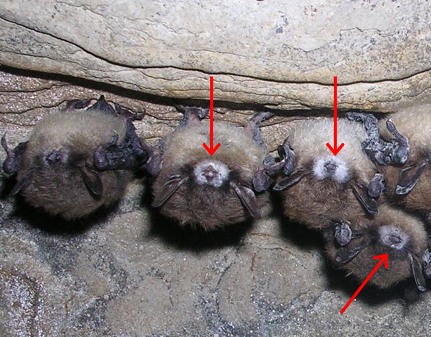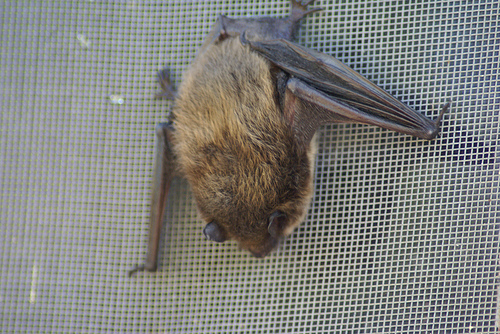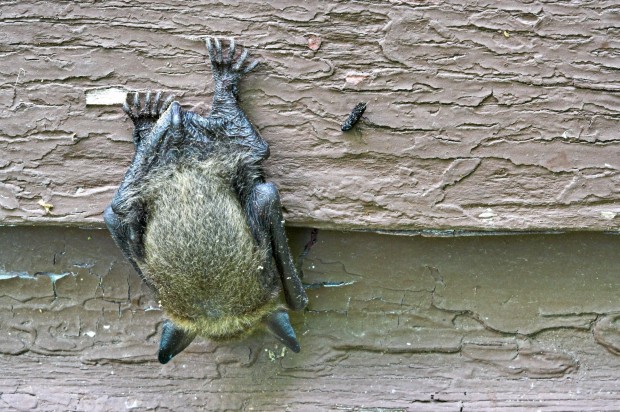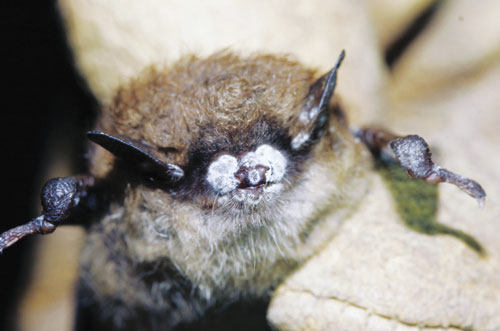Though many people abhor the thought or the presence of bats, gardeners and farmers know that bats in North America are our friends. They consume many many times their weight in insects-insects that devastate garden plants and crops. I am sure they have been a model for many a horror film character, but they actually are great friends of the garden.
A fungal disease first identified in New York in 2006 infects the skin of bats-all species of bats. In the final stages of infection, the fungus grows on the muzzles of bats-thus the name White Nose Syndrome. The origin of the fungus is unknown, but it is known that it thrives in moist places, and cannot tolerate temperatures above 68 degrees. This means that the fungus is active and irritating to the bats when they are hibernating. During the hibernation period, bats “wake up” periodically just to do a systems check-and then the quickly fall back to sleep. The energy it takes to rouse them from their torpor and power up to make this check comes from their fat reserves. The fungus makes them wake up much too often, as it is an irritant, and a wakeup call to their immune system. What should be an intermittent check gets to be a life threatening event.
From a radio program on Stateside, “It wakes bats up from hibernation too frequently, once every week. In order to go from a hibernating temperature of 45 degrees, raise their body temperature to 99 degrees, and go back down to 45 degrees takes as much energy as they would use in 60 days of continuous hibernation. Because they wake up frequently, the run out of fat by early February, and die of starvation.
I have read about this in some detail. There is disagreement about whether our Michigan bats have been affected yet, but it is known that the mortality rates in infected caves can be as high as 95%. A bat who has run out of energy, whose fat has been entirely used up fighting this fungus, may be forced to wake up, and fly. On the fly in February, there is no food available for them. Our landscape is usually blanketed with snow in February. The opportunities to eat are few and far between. Bats that come out of hibernation too early-enormous danger, dead ahead.
The danger faced by any living thing in a natural world- an ordinary event. A disease that is known to kill vast numbers of bats may be ordinary, but it is alarming. Many of the bats in the Upper Peninsula of Michigan hiberate in the caves created by mining in the west. Those caves are remote. One can only hope they will escape what poses a very serious threat to all species of bats that live in North America.
The danger this fungus poses to bat populations is terrifying. I have read some articles that suggest it could wipe out entire species of bats. These little creatures rarely bother anyone. If I am outside on the deck in the summer after dark, I see them flying around-feeding on those bugs that would otherwise bedevil my garden. Bats cannot really protect themselves from disease. They do not have internists with whom they can make an appointment. This plague on the bats has been on my mind for the better part of two days. As for the fungus, it has a life and a niche too. Passing by the blackspot on the roses, or the mildew on the phlox is not that tough. However a world without bats-not good. It is not only dangerous to garden, it is dangerous to live.
I so hope someone will be able to help the bats.






Nature’s “cruel trick” of survival-of-the-fittest perhaps? 5% SURVIVAL is intriguing, and may be nature’s plan.
Dear Alan, Some bat populations are wiped out by 100%. But let’s assume that in some cases 5% survive. Does that constitute a viable breeding population? I am not a biologist-I can’t answer this. I just know that all manner of people who grow things need the bats. Healthy bats. Those things that happen in the garden that we are powerless to prevent-vicious cold, ice storms, hurricanes-these things make gardeners well aware of the danger that being alive poses. Thanks for writing, Deborah
i hope too. I love bats so much.
They aren’t so gorgeous. They are scary. But they are true friends of the garden. I fear for them. Would that I knew how to treat this.
Deborah. I can’t say I’ve ever felt sorry for a bat before, until your mention of their current plight. Upon googling white nose syndrome, I learned that the same fungus exists among bats in Europe but without the same devastation because those bats evolved to withstand it’s effects. My guess is what probably happened here was someone smuggled in a few of the European variety, along with their WNS, and now an epidemic has taken hold. Whatever the case, there are articles dating to as early as Mar ’10 stating that the same drug used to fight foot fungus was found to be effecive on WNS, but how to administer it without affecting other animal and plant species that also frequent caves, via mass-spraying for example, was the problem posed. There are no recent articles that I could find about whether they’ve found a work-around to date. Another plan proposed was to provide heated areas in caves for the wakened bats so they don’t burn all their energy shivering in the cold caves. All very interesting, and I hope they figure out a proper remedy. As I mentioned, never thought much about bats, except at those times when, hands clasped overhead, I’ve run from my mailbox in to the house because the little dive-bombers seemed out to get me. Much to the amusement of my neighbors, I’m sure. Thanks for the enlightenment, Deborah. Tom in NC.
Dear Tom, In fact, lots of living creatures have to fend for themselves. Only people, and beloved pets, have the luxury of seeing and being treated by a physician. Many gardeners object to treating any illness or insect infestation in their garden-I understand this. And I understand the concept of survival of the fittest. All of that notwithstanding, I am still worried about our native bats. Thanks for your additional research! Deborah
Deborah. The other interesting point I read was that the spread of the disease from one cave to another is lbeing attributed not to the bats themselves, but to “cavers” hauling their exposed clothing and equipment from cave to cave. And why some popular caves and abandoned mines have since been closed to the public. I guess anywhere man sets his foot can be unknowingly deleterious to nature as it doesn’t take much to upset it’s balance. Tom in NC.
I’m sorry to hear this. And I am glad some places have closed the caves to people. I hope it helps.
Yes, very worried about these fascinating, extraordinarily beneficial creatures, so thanks for posting on this, Deborah.
They don’t scare me, although I have never been trapped in a room with one. It scares me much more to think about doing without them. They criss cross my garden at night all summer long. Not that I love the bugs-but the only pesticide I use are my own fingers. I have no qualms about squashing bugs. Mostly I rely on the bats to keep my bug populations at a reasonable level. I shudder to think that such a reclusive garden friend is under siege from a deadly fungus.